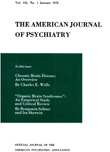UNITY AND DIVERSITY OF SCHIZOPHRENIA: CLINICAL AND LOGICAL ANALYSIS OF THE CONCEPT OF SCHIZOPHRENIA
Abstract
1. This clinical and logical analysis of the concept of schizophrenia is drawn from a statistical work on 366 cases studied for an average of 15 years, with a catamnestic period of 5 years at least.
2. As a chronic psychosis, schizophrenia must be separated from acute delusional psychoses.
3. As a chronic delusion tending to dissociation of the ego (with breaking of the communications with others and alteration of the reality) schizophrenia is different from the other forms of chronic delusions (paranoia and paraphrenia).
4. As a delusion, schizophrenia is different from the neuroses.
5. It is only these delimitations that will enable us to define clearly the group of schizophrenias.
Access content
To read the fulltext, please use one of the options below to sign in or purchase access.- Personal login
- Institutional Login
- Sign in via OpenAthens
- Register for access
-
Please login/register if you wish to pair your device and check access availability.
Not a subscriber?
PsychiatryOnline subscription options offer access to the DSM-5 library, books, journals, CME, and patient resources. This all-in-one virtual library provides psychiatrists and mental health professionals with key resources for diagnosis, treatment, research, and professional development.
Need more help? PsychiatryOnline Customer Service may be reached by emailing [email protected] or by calling 800-368-5777 (in the U.S.) or 703-907-7322 (outside the U.S.).



